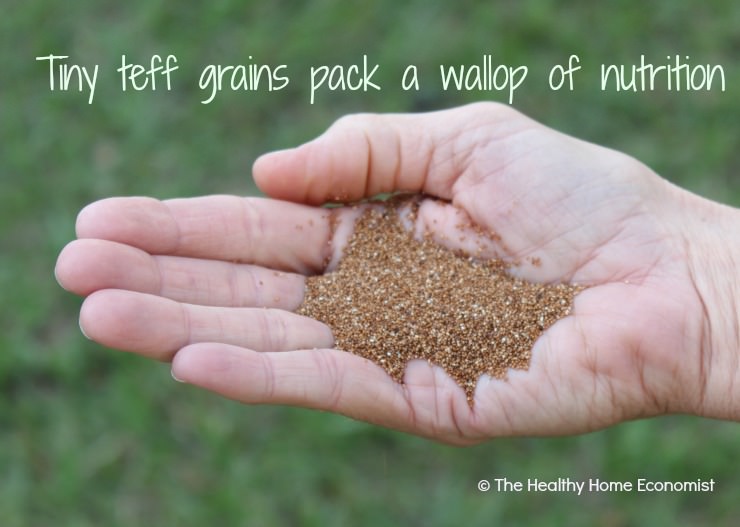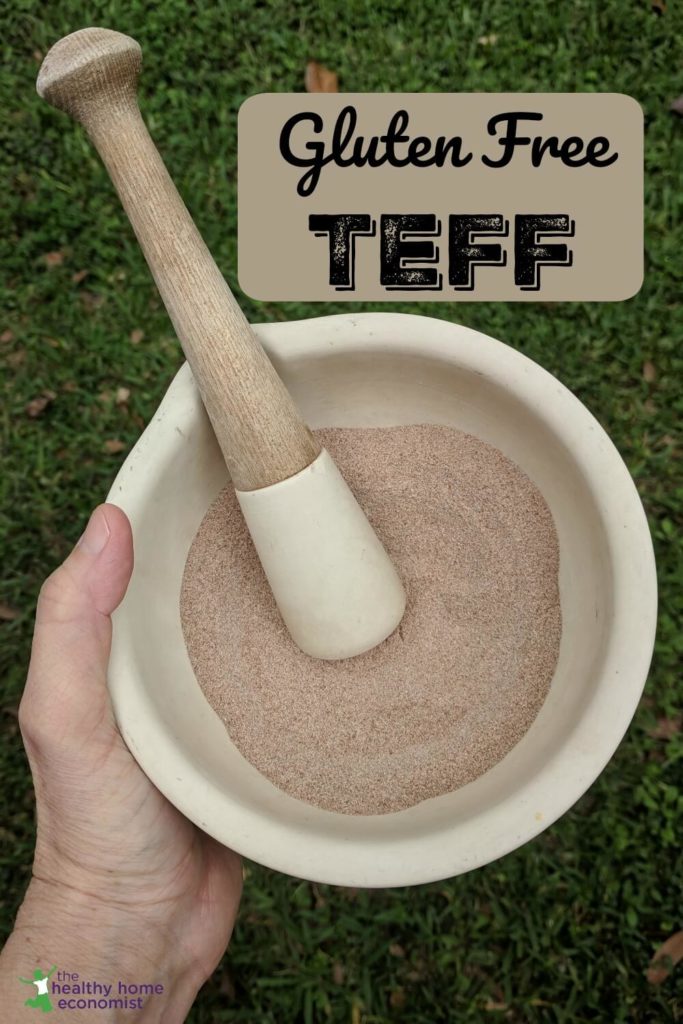 I first tasted the delicious, gluten free grain known as teff shortly after my husband and I were married. We met after work at an Ethiopian restaurant that we’d been wanting to try for quite some time. My husband was born and lived his early years in Uganda, and he was eager to introduce me to some of the flavors of his home continent.
I first tasted the delicious, gluten free grain known as teff shortly after my husband and I were married. We met after work at an Ethiopian restaurant that we’d been wanting to try for quite some time. My husband was born and lived his early years in Uganda, and he was eager to introduce me to some of the flavors of his home continent.
I was immediately enthralled and delighted by the basket of soft, spongy flatbread that was brought to our table to use as an edible utensil for our meat stew.
Never having experienced the light, slightly nutty flavor of teff before, I asked the waitress about the bread’s origins. She proudly explained that injera is a traditional fermented bread that is a staple in Ethiopia.
Traditional Teff Consumed for Thousands of Years
According to the Whole Grains Council, teff is thought to have made its debut in the human diet around 4000 B.C. in what is today the country of Ethiopia. Ethiopians obtain approximately two-thirds of their dietary protein from teff. The ultra tiny grain, smaller even than a chia seed, is what Ethiopia’s famously competitive long distance runners credit for their energy and stamina.
The tiny size of the teff grain, which can appear dark reddish brown to yellowish brown to ivory, made it the ideal food for the semi-nomadic life common throughout Ethiopian history. Only a handful of seed as shown in the picture above will sow an average size field no matter whether water-logged or dry! Thus, this practical grain is a dependable staple no matter what the environmental conditions.
In addition to climate, teff will grow at a variety of altitudes – from sea level to nearly 10,000 feet (300 meters). Its incredible versatility and hardiness has resulted in cultivation in diverse areas around the world. This includes mountainous Idaho, dry Australia, and low lying, wet areas of the Netherlands and India.
Is Teff Gluten Free?
Teff is one of the most nutritious of all gluten free grains.
Despite its tiny size, teff leads all other grains, gluten free or not, in calcium by a wide margin. This includes nutritious einkorn and millet.
It leads Paleo friendly foods used to substitute for grains like cassava and buckwheat as well.
Nutritional Information
Teff is high in many critical vitamins and minerals.
Magnesium, calcium, potassium, zinc, copper, and manganese round out the top six mineral nutrients.
Teff is extremely rich in B complex. It contains excellent amounts of choline, Vitamin B3 (niacin), Vitamin B6, Thiamin, Pantothenic Acid, and Riboflavin.
Teff Contains a Special Kind of Fiber
The biggest health benefit of teff may very well be its unique type of prebiotic starch.
Teff is high in resistant starch, a special type of dietary fiber only recently getting much attention from the research community. Resistant starch benefits blood sugar management, weight control, and overall health of the large intestine.
Up to 40% of the carbohydrates in teff are composed of gut strengthening resistant starches!
Milling Teff Grains
There is only downside to this amazing grain in my experience cooking and baking with it. Can you guess? It is so tiny that most grain mills can’t even grind it into flour!
Unless you have a special grain mill that can manage teff’s ultra miniscule size, it is best eaten in whole form as a delicious, mild, slightly nutty tasting porridge. Alternatively, you can add it to soups or stews to thicken and add texture.
 How to Sprout Teff Grains
How to Sprout Teff Grains
The tiny size of this gluten free grain requires only 36 hours or less to sprout – the shortest time of any grain. This is likely due to low amounts of mineral blocking phytic acid, although I was unable to find definite numbers on this to confirm.
If you would like to sprout your teff grains before cooking to add additional vitamins and render it even more digestible, follow these steps before cooking:
- Place 1 cup in a glass sprouting jar (I use these).
- Rinse the grains several times with filtered water until thoroughly wet. Drain completely.
- Lay the sprouting jar on its side to allow the circulation of air.
- Every few hours, rinse again and reset the jar on its side.
- Anywhere from a few hours to at most 36 hours (depending on the time of year and warmth/humidity in your home), the tiniest of buds will appear (they are very hard to see) and the sprouted teff grains will be ready for cooking (see toasting step below).
Teff Recipes
Toasted or soaked teff porridge is my personal favorite for a hot breakfast cereal. It beats out even that old stand-by overnight oatmeal. It is easy to make and a great place to start with teff in your kitchen.
This is especially true if you don’t currently have a specialized appliance that permits easy grinding of the tiny grains into fresh flour. I don’t recommend purchasing the flour for baking, as much of the nutritional benefit is lost within a few days of grinding.
If you enjoy the taste of teff after trying it, I recommend gluten free soaked amaranth porridge too. Amaranth is also slightly nutty in flavor and offers an excellent plant protein profile.
References
How to Mix and Use Gluten Free Flour
Boma: A Taste of Africa (Best Restaurant at Disney World)








Bob’s Red Mill makes a teff flour. Is thhis just like other grains, where it is less nutritious once milled into flour? I have a recipe for making teff pancakes with raw cacao and chocolate protein powder.
Its not less nutritious milled into flour … it’s just that buying already milled flour at the store has no nutritional benefits as it’s been weeks or even months since it was milled. Freshly milled flour is nutritious. Store flour is not because it’s not fresh.
This properties Health methods are very super idealistic although I never purchase as of yet I believe this could be very wise to consider also convincing I notice wide varieties on products and books your Living Green in a Artificial World and Getting your Fats Striaght! When buying products I have problems looking for natural products without artificial when they spells natural on the label half good and half bad What happens when the doctor tells me to stay away from cookies cakes and pies so I Were thinking what if these wonderful flour without gluten and less fats!
Is sprouted teff edible without cooking, as in a salad or smoothie?
You still need to cook it after sprouting.
I tried the soaked porridge after reading this, and we love it! Thanks for teaching me about a great food that I never knew about. We soak all our grains or make sourdough, and this one is a great way to replace the oatmeal I’m now leerie of (my kids are battling cavities). A question, though — my toddler doesn’t seem to digest the teff at all. He had 3 diapers that looked like the porridge after this meal! Does that mean he shouldn’t have it?? Or maybe it’s a normal toddler thing? I’d love any advice.
Babies shouldn’t really have grains until after a year old.
He’s turning two in a couple months, so he’s old enough for them. I started giving him sourdough bread at 14 months, and now we’re trying some hot cereals.
Finding organic teff is d i f f i c u l t! I found a local source and bought a large quantity (thinking it was organic) only to find out that they do, in fact, spray an herbicide to control pigweed that grows along with the teff. My local co-op does stock some organic teff, but it is very dirty and requires significant washing (difficult with such a small gain) and still I get some gritty bits. I do love the taste, though.
so, I was buying the bob mill teff, this mean it is sprayed.
I would love to try a bread recipe using Teff flour — do you have any please?
Hi there, I import fresh Teff injera (bread) from Ethiopia every Wednesday
If you tell me which area you live, I will tell you which stores you can find it. Or you can contact me on this phone number 07949949420
Some info on US-grown teff pesticide use:
(from 2009)
http://www.ethiopianreview.com/index/10648
Round-up was allowed then and it’s likely 2-4 D products have been approved by now unless anyone has found info to the contrary.
I’ll definitely be waiting it out and searching for an organic option.
Made this for breakfast today! THe soaked version…I wonder if you can soak in 1 cup water overnight and cook it in milk the next morning for a more “cream of wheat” version? I haven’t had that in over 20 years!
I’m sure that would work fine 🙂 So many ways to mix it up to your preference.
i can’t find organic teff. I ky nov red mill brand. Is that alright or is teff treated with lots of pesticides and chemicals? I try to eat an all organic diet. Thanks!
Teff is naturally highly resistant to pests and other issues triggered by adverse environmental conditions. I doubt that it is highly sprayed. If anyone has a link to information about this, please post.
Most injera from Ethiopian restaurants is made with wheat and some teff. A few restaurants will make the injera with teff only if you request 3 days in advance – the wait time is justified because it needs to be fermented.
Does the book Flatbreads and Flavors have a recipe for injera made only with teff/ no wheat? I have only seen recipes that include wheat.
Thanks!
Thank you for this tip! I will be sure to clarify and order teff only injera bread a few days ahead as necessary the next time we eat at an Ethiopian restaurant.
When ever you go to Ethiopian Restaurant ask for “TSHAY Fresh Teff injera” it’s 100% pure teff. It comes with two colour dark brown or white. Enjoy